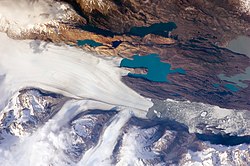Upsalaglaciären

Upsalaglaciären (spanska: Glaciar Upsala) är en glaciär. Den är belägen i Los Glaciares nationalpark i Argentina. Det var den svenske upptäcktsresande Percy Quensel som namngav glaciären efter staden Uppsala under en forskningsresa 1907/1908.[1]
Glaciären är ungefär 60 km lång samt upp till 10 km bred och täcker en yta av ungefär 595 km². Den slutar vid Lago Argentino.[2]
Referenser
- Den här artikeln är helt eller delvis baserad på material från engelskspråkiga Wikipedia, 26 april 2013.
Litteratur
- Bo Sundqvist, Upsala-glaciären – till hundraårsminnet av expeditionen till Patagonien. Acta Universitatis Upsaliensis. Skrifter rörande Uppsala universitet. B. Inbjudningar 163. Uppsala 2011.
Noter
- ^ http://www.unt.se/uppsala/upsalaglaciaren-en-bild-av-varmare-klimat-2762612.aspx
- ^ Bao, Sandra (2018). ”Glaciar Upsala” (på tyska). Lonely Planet Reiseführer Argentinien. Mair Dumont. sid. 985
Media som används på denna webbplats
The Southern Patagonian Icefield of Argentina and Chile is the southern remnant of the Patagonia Ice Sheet that covered the southern Andes Mountains during the last ice age. This detailed astronaut photograph illustrates the terminus of one of the ice-field’s many spectacular glaciers—Upsala Glacier, located on the eastern side of the ice-field.
This image was taken during spring in the Southern Hemisphere, and icebergs were calving from the glacier terminus into the waters of Lago Argentino (Lake Argentina, image right). Two icebergs are especially interesting because they retain fragments of the moraine (rock debris) that forms a dark line along the upper surface of the glacier. The inclusion of the moraine illustrates how land-based rocks and sediment may wind up in ocean sediments far from shore.
Moraines are formed from rock and soil debris that accumulate along the front and sides of a flowing glacier. The glacier is like a bulldozer that pushes soil and rock in front of it, leaving debris on either side. When two glaciers merge (image centre), moraines along their edges can join to form a medial moraine that is drawn out along the upper surface of the new glacier.